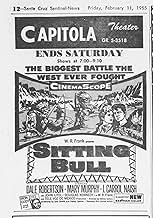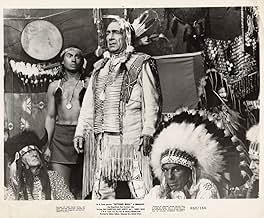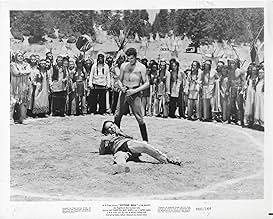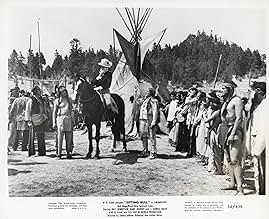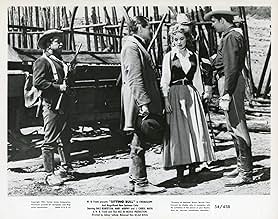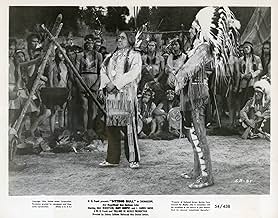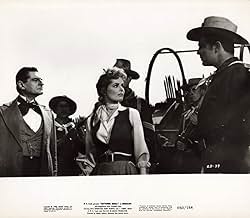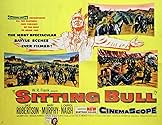A cavalry officer sympathetic to the wronged Sioux fixes a meeting between Chief Sitting Bull and President Grant but a dishonest Indian Agent and a hateful General Custer test the Sioux's p... Read allA cavalry officer sympathetic to the wronged Sioux fixes a meeting between Chief Sitting Bull and President Grant but a dishonest Indian Agent and a hateful General Custer test the Sioux's patience, threatening to derail the peace-talks.A cavalry officer sympathetic to the wronged Sioux fixes a meeting between Chief Sitting Bull and President Grant but a dishonest Indian Agent and a hateful General Custer test the Sioux's patience, threatening to derail the peace-talks.
- Charles Wentworth
- (as Bill Hopper)
- Webber - Indian Agent
- (as Tom Brown Henry)
- White Cloud
- (uncredited)
- Trooper Foster
- (uncredited)
- Young Buffalo
- (uncredited)
- Trooper
- (uncredited)
- Capt. Swain
- (uncredited)
- Director
- Writers
- All cast & crew
- Production, box office & more at IMDbPro
Featured reviews
But the "Bottom-Line" is that Most Movies are Made as Entertainment with a Profit Motive.
So Historical "Facts" Aside, as an Entertaining Piece of an Early Cinemascope Film (the first Independent) In the First-Half of the "Decade of the Western",
You Could Do Much Worse than this Nobly Intended Movie about the Sioux Chief "Sitting Bull",
His Constant Battles with "Forked-Tongue" Treaties and the General Inhumane Treatment of Prisoners,
Leading Up to the "Battle of Little Big-Horn" and Custer's Last Stand.
Playing Fast and Loose with some "Facts" is a Consideration to Make the Movie Box-Office Friendly.
But the Film Deserves Credit for Bucking the Trend of "White-Man Wins Called Victory...Indian Wins Called a Massacre" and Taking a Liberal Other-Sided Approach.
In the End it is Not Guilty of Over-Indulging the Re-Writing of History and Shows Respectable Behavior on Both Sides.
The Casting is Weak but the Story and the Epic Battles are Well Staged, Engaging, and Somewhat Informative.
All Things Considered...A Fine Film and Definitely...
Worth a Watch.
The story revolves around an officer who has been demoted. Bob Parrish (Dale Robertson) is not your typical cavalry officer, as he thinks that the American government should respect and treat the natives much better than they do. As he put it, 'they just want to live and raise their families'. But folks like General Custer and the rest give him a lot of guff and they seem to follow the old axiom, 'the only good Indian is a dead Indian'. What's to become of him and his mission to work WITH the natives instead of AGAINST them?
It is ironic that not only did Iron Eyes Cody appear in the film as Crazy Horse, but he was the consultant to the production about native culture. Only later in life did folks learn that Cody (the most American Indian looking guy on the planet) was actually an Italian!! But you can't blame the film....at the time everyone thought Cody was exactly what and who he pretended to be! But he and the filmmakers STILL got so much right in this one...and the movie holds up far better than most from the genre*. Well worth seeing and an excellent picture in so many ways.
*For the worst possible depiction of this same story, try "They Died With Their Boots On". While the cast was incredibly impressive (with Errol Flynn and Olivia de Havilland), the facts are pretty much tossed out the window and Custer is depicted as a great man...not the incompetent he actually was.
During the movie, I was also struck by the lush score. Naturally, the TV network didn't have the decency to show all the credits, but to my ear it sounded like the outstanding work of Raoul Kraushaar -- and praise all the gods of technology for IMDb, I was right.
In my opinion, he is a terribly under-rated composer. Even the cheapest Allied Artists movies attain the ranks of quality when he wrote the score.
J. Carroll Naish as the title character is another under-rated actor. That is, he does not seem to be known among viewers although apparently he was never out of work. He almost always played some accented character, some Latin or European or, as in this case, "Indian" character. And he was almost always extremely believable.
The rest of the cast, from the excellent Dale Robertson to the excellent John Hamilton, were almost uniformly perfect.
This B film from MGM is yet another version of the events of surrounding the Little Big Horn battle where Douglas Kennedy as Custer got himself surrounded and massacred by some angry Sioux Indians. This version does show the Indian side of the events, how badly treated they were on reservations, how the whites once word of gold being discovered in their sacred Black Hills of Dakota territory systematically broke the treaties signed. Yet in fact the film went a bit overboard with presenting the Indian side and took great liberty with the facts.
Dale Robertson's an army major who zealously follows his orders about respecting the Indian rights, to the dismay of former General now Colonel George Armstrong Custer. Robertson's maverick tendencies wouldn't be liked in the army in any event, but his fiancé Mary Murphy who is General John Litel's daughter wants an upwardly mobile career man and Robertson doesn't look like a good bet. For standing on his beliefs Robertson loses her to newspaper reporter William Hopper.
But Dale gets himself in an even bigger jackpot. He's got an agreement with his former commander Ulysses S. Grant who is now president of the United States, the big chief of all the white folks. But when Custer moves prematurely and gets massacred and troops are sent on reprisal, Robertson does a very daring and potentially foolish thing to keep the peace process alive. That's the essence of our story.
Which of course never did happen. Neither did Ulysses S. Grant as played by John Hamilton on hiatus from the Superman series ever come west to negotiate with J. Carrol Naish as Sitting Bull. That's the biggest flaw in this film.
Murphy's character doesn't ring true either. From a woman who makes no bones about her desire for an upwardly mobile man, she does an about face and would make Tammy Wynette proud if Tammy had in fact ever seen Sitting Bull.
The film's heart is the in the right place, but the rest of it is out to lunch.
Though I will say one thing. If what I read is true about Mary Murphy's bout with Montezuma's revenge on location for this movie, she may have given one of the great performances of all time just getting through this film without a hint on screen.
Did you know
- TriviaThe film was shot outside of Mexico City, and star Mary Murphy caught "Montezuma's Revenge" and was very ill throughout the six-week shoot. Most of her scenes are relatively brief, possibly because of this.
- GoofsIn many of the scenes the women are obviously men.
- Quotes
Sitting Bull: I have wanted peace. I have prayed for peace. There have been battles. But when the white soldiers win a battle, they call it victory. When the Indians win, they call it massacre.
- Crazy creditsDuring the opening titles, the film's 'Technical Advisor and Indian Costumes' is credited to 'Iron Eyes Cody' who is also parenthetically credited as being a '(Famous T.V. Star)'.
- ConnectionsFeatured in Le Massacre des Sioux (1965)
- SoundtracksGreat Spirit
Music and Lyrics by Max Rich
- How long is Sitting Bull?Powered by Alexa
Details
- Release date
- Countries of origin
- Language
- Also known as
- Sitting Bull, el indio heroico
- Filming locations
- Production companies
- See more company credits at IMDbPro
Box office
- Gross US & Canada
- $1,500,000
- Runtime1 hour 45 minutes
- Sound mix
- Aspect ratio
- 2.55 : 1
Contribute to this page



